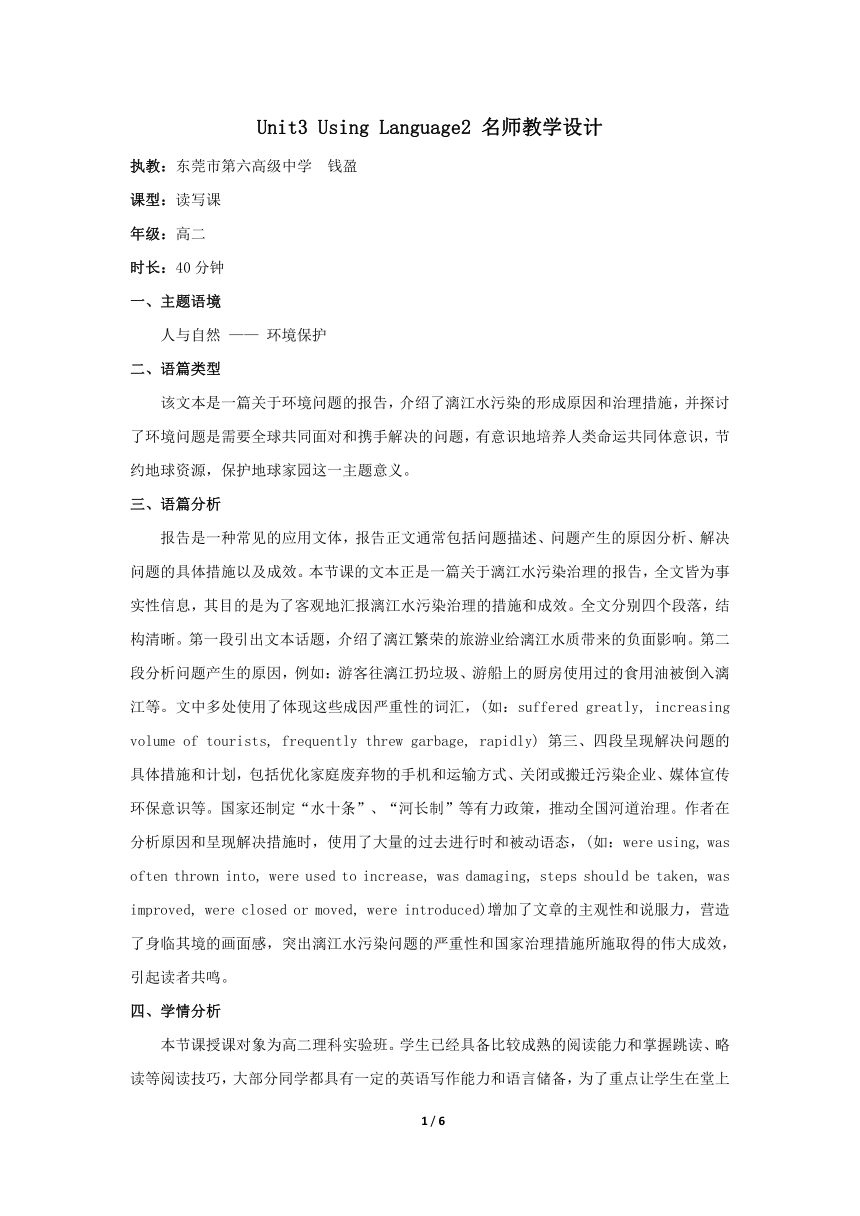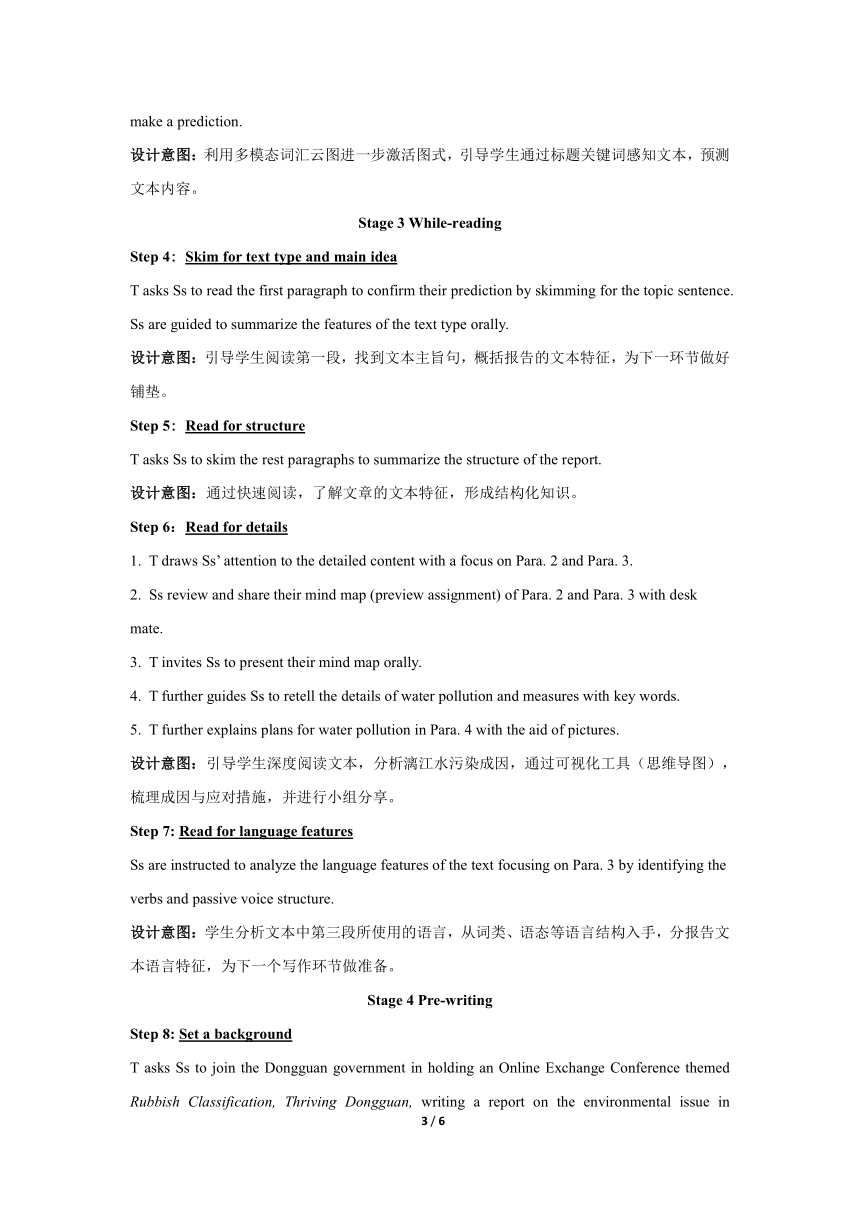人教版(2019)选择性必修第三册 Unit3 Environmental Protection Using Language2 名师教学设计
文档属性
| 名称 | 人教版(2019)选择性必修第三册 Unit3 Environmental Protection Using Language2 名师教学设计 |  | |
| 格式 | doc | ||
| 文件大小 | 47.0KB | ||
| 资源类型 | 教案 | ||
| 版本资源 | 人教版(2019) | ||
| 科目 | 英语 | ||
| 更新时间 | 2023-03-13 07:49:22 | ||
图片预览



文档简介
Unit3 Using Language2 名师教学设计
执教:东莞市第六高级中学 钱盈
课型:读写课
年级:高二
时长:40分钟
主题语境
人与自然 —— 环境保护
语篇类型
该文本是一篇关于环境问题的报告,介绍了漓江水污染的形成原因和治理措施,并探讨了环境问题是需要全球共同面对和携手解决的问题,有意识地培养人类命运共同体意识,节约地球资源,保护地球家园这一主题意义。
语篇分析
报告是一种常见的应用文体,报告正文通常包括问题描述、问题产生的原因分析、解决问题的具体措施以及成效。本节课的文本正是一篇关于漓江水污染治理的报告,全文皆为事实性信息,其目的是为了客观地汇报漓江水污染治理的措施和成效。全文分别四个段落,结构清晰。第一段引出文本话题,介绍了漓江繁荣的旅游业给漓江水质带来的负面影响。第二段分析问题产生的原因,例如:游客往漓江扔垃圾、游船上的厨房使用过的食用油被倒入漓江等。文中多处使用了体现这些成因严重性的词汇,(如:suffered greatly, increasing volume of tourists, frequently threw garbage, rapidly) 第三、四段呈现解决问题的具体措施和计划,包括优化家庭废弃物的手机和运输方式、关闭或搬迁污染企业、媒体宣传环保意识等。国家还制定“水十条”、“河长制”等有力政策,推动全国河道治理。作者在分析原因和呈现解决措施时,使用了大量的过去进行时和被动语态,(如:were using, was often thrown into, were used to increase, was damaging, steps should be taken, was improved, were closed or moved, were introduced)增加了文章的主观性和说服力,营造了身临其境的画面感,突出漓江水污染问题的严重性和国家治理措施所施取得的伟大成效,引起读者共鸣。
学情分析
本节课授课对象为高二理科实验班。学生已经具备比较成熟的阅读能力和掌握跳读、略读等阅读技巧,大部分同学都具有一定的英语写作能力和语言储备,为了重点让学生在堂上进行输出,巩固输入部分提炼的结构化知识和语言表达,课前学生通过学案对课文进行了预习,并两人一组通过制作思维导图,充分预习了文本第二、三段中重点内容。在本课学习之前,学生对环保类文本的介绍还没有系统的归纳和梳理,学生对漓江水污染治理问题不太熟悉,对如何撰写“环境问题报告”也了解不多。因此,本节课重在指导学生掌握报告文本的写作方法。
教学目标
在本课学习结束时,学生能够:
阅读漓江水污染的成因和治理措施,理解环境问题是需要全球共同面对和携手解决的问题,培养文化意识。
观察文本的标题、词汇云图和文本内容等语篇特征,了解报告文本的语篇结构和写作方法,初步建立文本意识。
通过跳读和略读,获取环境问题报告语篇的结构和语言特征,并迁移到笔头和口头输出中,学会撰写环境问题报告以及口头分享,培养语言表达能力。
利用评价标准评价自己与他人的作品,培养批判性思维能力,指向学科素养发展。
结合东莞打造“湾区都市,品质东莞”推出的《东莞市生活垃圾分类三年行动方案(2020-2022)》,指导学生撰写一篇关于“垃圾分类”的报告,把所学的知识进行迁移与创新。
教学过程
Stage 1 Lead-in
Step 1:Watch a video
Ss watch a video introducing the beautiful scenery of Li River and ask Ss to guess where it is.
Step 2:Enjoy some pictures
T offers more pictures about the Li River and Ss make a contrast between the clean water and the polluted water.
设计意图:
利用视频和图片,创设语境,导入主题。通过视频了解漓江的自然风光,激活学生背景知识并引出问题让学生思考。
Stage 2 Pre-reading
Step 3: View and predict
T asks Ss to read the title and view the word cloud of the passage. Ss find out the key words and make a prediction.
设计意图:利用多模态词汇云图进一步激活图式,引导学生通过标题关键词感知文本,预测文本内容。
Stage 3 While-reading
Step 4: Skim for text type and main idea
T asks Ss to read the first paragraph to confirm their prediction by skimming for the topic sentence. Ss are guided to summarize the features of the text type orally.
设计意图:引导学生阅读第一段,找到文本主旨句,概括报告的文本特征,为下一环节做好铺垫。
Step 5: Read for structure
T asks Ss to skim the rest paragraphs to summarize the structure of the report.
设计意图:通过快速阅读,了解文章的文本特征,形成结构化知识。
Step 6:Read for details
T draws Ss’ attention to the detailed content with a focus on Para. 2 and Para. 3.
Ss review and share their mind map (preview assignment) of Para. 2 and Para. 3 with desk mate.
T invites Ss to present their mind map orally.
T further guides Ss to retell the details of water pollution and measures with key words.
T further explains plans for water pollution in Para. 4 with the aid of pictures.
设计意图:引导学生深度阅读文本,分析漓江水污染成因,通过可视化工具(思维导图),梳理成因与应对措施,并进行小组分享。
Step 7: Read for language features
Ss are instructed to analyze the language features of the text focusing on Para. 3 by identifying the verbs and passive voice structure.
设计意图:学生分析文本中第三段所使用的语言,从词类、语态等语言结构入手,分报告文本语言特征,为下一个写作环节做准备。
Stage 4 Pre-writing
Step 8: Set a background
T asks Ss to join the Dongguan government in holding an Online Exchange Conference themed Rubbish Classification, Thriving Dongguan, writing a report on the environmental issue in Dongguan.
设计意图:创设语境,培养学生的创造性思维,增强语言实用性,实现学生的能力迁移。
Step 9: Brainstorm for ideas
T stimulates Ss’ inspiration by introducing the Action Plan for Rubbish Classification in Dongguan and offering pictures.
T asks Ss to brainstorm for more ideas in groups and think of the problems and measures and then share their ideas in groups.
3. T provides more ideas for Ss’ reference.
设计意图:发散思维,以头脑风暴为突破手段,引导学生对迁移话题进行逻辑性和批判性地探讨,能够结合生活情况分析城市垃圾脏乱等成因,治理措施,垃圾分类实施过程和成效等。
Stage 5 While-writing
Step 10: A writing circle
T divides Ss into groups of four to form a writing circle, each S playing different roles.
T asks Ss to show their work sheets with different colors and identify their tasks (Blue: write a topic paragraph; Yellow: write a problem paragraph; Green: write a measures paragraph; Pink: write a plan paragraph).
T guides Ss to do the writing circle.
Ss write their own part individually for 5 minutes. Ss put what they have written together to make a complete report.
设计意图:以“写作圈”的形式,小组合作探究完成“垃圾分类”环保报告写作,内化报告的结构和语言。
Stage 6 Post-writing
Step 11: Self-assess & peer-assess
After writing, T draws Ss’ attention to the evaluation chart.
T shares Ss’ writing with the whole class and demonstrate how to assess the writing by referring to the chart.
3.Ss evaluate their own writing and peer-assess their group members’.
设计意图:师生共评,结合学生作品的特点,肯定学生的创新意识和积极的态度。
Step 12: Give a report in the Online Exchange Conference
T invites Ss to give a report in the Online Exchange Conference orally.
设计意图:给予学生自由发挥的空间,激发学生的想象力,在展示作品的过程中,实现能力迁移。
Stage 7 Summary and Assignment
Step 13: Make a summary
T makes a brief summary of what Ss have learnt in class.
T uses the quotation on the opening page of this unit to summarize the topic and stress the importance of environmental protection.
Assignment
Option 1: Ss polish their group report and upload them on a social media platform and share online.
Option 2: Ss design a poster themed “Rubbish Classification, Thriving Dongguan” with group members.
设计意图:对本堂课和本单元的学习进行归纳总结,深化主题意义,加强德育浸润。通过名人引言,鼓励学生保护环境,从内而外提升自我,努力实现人生价值。
Blackboard Design
七、教学反思
本节课以“保护环境”为主题语境,基于对文本和学情的分析,执教老师确定了本课的教学目标,并设计了五个层次的教学活动。教师先借用旅游短片、实景图片及头脑风暴环节,创设情境,引入本节课主题,激活学生已知,调动学生学习积极性。随后,教师引导学生关注文本体裁,梳理结构。利用思维导图可视化工具帮助学生获取事实性信息,通过小组讨论内化信息。接着,教师指导学生深度理解文本,通过“写作圈”活动,完成模仿写作。最后,提供真实情境,展示小组成果,并对学生作品进行评价,发展学生的批判性思维,鼓励创意表达。最后的作业设计既包括巩固所学内容的任务,也包括了扩展性任务,分层可选择的作业有效地兼顾了学生的个体差异。
2 / 2
执教:东莞市第六高级中学 钱盈
课型:读写课
年级:高二
时长:40分钟
主题语境
人与自然 —— 环境保护
语篇类型
该文本是一篇关于环境问题的报告,介绍了漓江水污染的形成原因和治理措施,并探讨了环境问题是需要全球共同面对和携手解决的问题,有意识地培养人类命运共同体意识,节约地球资源,保护地球家园这一主题意义。
语篇分析
报告是一种常见的应用文体,报告正文通常包括问题描述、问题产生的原因分析、解决问题的具体措施以及成效。本节课的文本正是一篇关于漓江水污染治理的报告,全文皆为事实性信息,其目的是为了客观地汇报漓江水污染治理的措施和成效。全文分别四个段落,结构清晰。第一段引出文本话题,介绍了漓江繁荣的旅游业给漓江水质带来的负面影响。第二段分析问题产生的原因,例如:游客往漓江扔垃圾、游船上的厨房使用过的食用油被倒入漓江等。文中多处使用了体现这些成因严重性的词汇,(如:suffered greatly, increasing volume of tourists, frequently threw garbage, rapidly) 第三、四段呈现解决问题的具体措施和计划,包括优化家庭废弃物的手机和运输方式、关闭或搬迁污染企业、媒体宣传环保意识等。国家还制定“水十条”、“河长制”等有力政策,推动全国河道治理。作者在分析原因和呈现解决措施时,使用了大量的过去进行时和被动语态,(如:were using, was often thrown into, were used to increase, was damaging, steps should be taken, was improved, were closed or moved, were introduced)增加了文章的主观性和说服力,营造了身临其境的画面感,突出漓江水污染问题的严重性和国家治理措施所施取得的伟大成效,引起读者共鸣。
学情分析
本节课授课对象为高二理科实验班。学生已经具备比较成熟的阅读能力和掌握跳读、略读等阅读技巧,大部分同学都具有一定的英语写作能力和语言储备,为了重点让学生在堂上进行输出,巩固输入部分提炼的结构化知识和语言表达,课前学生通过学案对课文进行了预习,并两人一组通过制作思维导图,充分预习了文本第二、三段中重点内容。在本课学习之前,学生对环保类文本的介绍还没有系统的归纳和梳理,学生对漓江水污染治理问题不太熟悉,对如何撰写“环境问题报告”也了解不多。因此,本节课重在指导学生掌握报告文本的写作方法。
教学目标
在本课学习结束时,学生能够:
阅读漓江水污染的成因和治理措施,理解环境问题是需要全球共同面对和携手解决的问题,培养文化意识。
观察文本的标题、词汇云图和文本内容等语篇特征,了解报告文本的语篇结构和写作方法,初步建立文本意识。
通过跳读和略读,获取环境问题报告语篇的结构和语言特征,并迁移到笔头和口头输出中,学会撰写环境问题报告以及口头分享,培养语言表达能力。
利用评价标准评价自己与他人的作品,培养批判性思维能力,指向学科素养发展。
结合东莞打造“湾区都市,品质东莞”推出的《东莞市生活垃圾分类三年行动方案(2020-2022)》,指导学生撰写一篇关于“垃圾分类”的报告,把所学的知识进行迁移与创新。
教学过程
Stage 1 Lead-in
Step 1:Watch a video
Ss watch a video introducing the beautiful scenery of Li River and ask Ss to guess where it is.
Step 2:Enjoy some pictures
T offers more pictures about the Li River and Ss make a contrast between the clean water and the polluted water.
设计意图:
利用视频和图片,创设语境,导入主题。通过视频了解漓江的自然风光,激活学生背景知识并引出问题让学生思考。
Stage 2 Pre-reading
Step 3: View and predict
T asks Ss to read the title and view the word cloud of the passage. Ss find out the key words and make a prediction.
设计意图:利用多模态词汇云图进一步激活图式,引导学生通过标题关键词感知文本,预测文本内容。
Stage 3 While-reading
Step 4: Skim for text type and main idea
T asks Ss to read the first paragraph to confirm their prediction by skimming for the topic sentence. Ss are guided to summarize the features of the text type orally.
设计意图:引导学生阅读第一段,找到文本主旨句,概括报告的文本特征,为下一环节做好铺垫。
Step 5: Read for structure
T asks Ss to skim the rest paragraphs to summarize the structure of the report.
设计意图:通过快速阅读,了解文章的文本特征,形成结构化知识。
Step 6:Read for details
T draws Ss’ attention to the detailed content with a focus on Para. 2 and Para. 3.
Ss review and share their mind map (preview assignment) of Para. 2 and Para. 3 with desk mate.
T invites Ss to present their mind map orally.
T further guides Ss to retell the details of water pollution and measures with key words.
T further explains plans for water pollution in Para. 4 with the aid of pictures.
设计意图:引导学生深度阅读文本,分析漓江水污染成因,通过可视化工具(思维导图),梳理成因与应对措施,并进行小组分享。
Step 7: Read for language features
Ss are instructed to analyze the language features of the text focusing on Para. 3 by identifying the verbs and passive voice structure.
设计意图:学生分析文本中第三段所使用的语言,从词类、语态等语言结构入手,分报告文本语言特征,为下一个写作环节做准备。
Stage 4 Pre-writing
Step 8: Set a background
T asks Ss to join the Dongguan government in holding an Online Exchange Conference themed Rubbish Classification, Thriving Dongguan, writing a report on the environmental issue in Dongguan.
设计意图:创设语境,培养学生的创造性思维,增强语言实用性,实现学生的能力迁移。
Step 9: Brainstorm for ideas
T stimulates Ss’ inspiration by introducing the Action Plan for Rubbish Classification in Dongguan and offering pictures.
T asks Ss to brainstorm for more ideas in groups and think of the problems and measures and then share their ideas in groups.
3. T provides more ideas for Ss’ reference.
设计意图:发散思维,以头脑风暴为突破手段,引导学生对迁移话题进行逻辑性和批判性地探讨,能够结合生活情况分析城市垃圾脏乱等成因,治理措施,垃圾分类实施过程和成效等。
Stage 5 While-writing
Step 10: A writing circle
T divides Ss into groups of four to form a writing circle, each S playing different roles.
T asks Ss to show their work sheets with different colors and identify their tasks (Blue: write a topic paragraph; Yellow: write a problem paragraph; Green: write a measures paragraph; Pink: write a plan paragraph).
T guides Ss to do the writing circle.
Ss write their own part individually for 5 minutes. Ss put what they have written together to make a complete report.
设计意图:以“写作圈”的形式,小组合作探究完成“垃圾分类”环保报告写作,内化报告的结构和语言。
Stage 6 Post-writing
Step 11: Self-assess & peer-assess
After writing, T draws Ss’ attention to the evaluation chart.
T shares Ss’ writing with the whole class and demonstrate how to assess the writing by referring to the chart.
3.Ss evaluate their own writing and peer-assess their group members’.
设计意图:师生共评,结合学生作品的特点,肯定学生的创新意识和积极的态度。
Step 12: Give a report in the Online Exchange Conference
T invites Ss to give a report in the Online Exchange Conference orally.
设计意图:给予学生自由发挥的空间,激发学生的想象力,在展示作品的过程中,实现能力迁移。
Stage 7 Summary and Assignment
Step 13: Make a summary
T makes a brief summary of what Ss have learnt in class.
T uses the quotation on the opening page of this unit to summarize the topic and stress the importance of environmental protection.
Assignment
Option 1: Ss polish their group report and upload them on a social media platform and share online.
Option 2: Ss design a poster themed “Rubbish Classification, Thriving Dongguan” with group members.
设计意图:对本堂课和本单元的学习进行归纳总结,深化主题意义,加强德育浸润。通过名人引言,鼓励学生保护环境,从内而外提升自我,努力实现人生价值。
Blackboard Design
七、教学反思
本节课以“保护环境”为主题语境,基于对文本和学情的分析,执教老师确定了本课的教学目标,并设计了五个层次的教学活动。教师先借用旅游短片、实景图片及头脑风暴环节,创设情境,引入本节课主题,激活学生已知,调动学生学习积极性。随后,教师引导学生关注文本体裁,梳理结构。利用思维导图可视化工具帮助学生获取事实性信息,通过小组讨论内化信息。接着,教师指导学生深度理解文本,通过“写作圈”活动,完成模仿写作。最后,提供真实情境,展示小组成果,并对学生作品进行评价,发展学生的批判性思维,鼓励创意表达。最后的作业设计既包括巩固所学内容的任务,也包括了扩展性任务,分层可选择的作业有效地兼顾了学生的个体差异。
2 / 2
